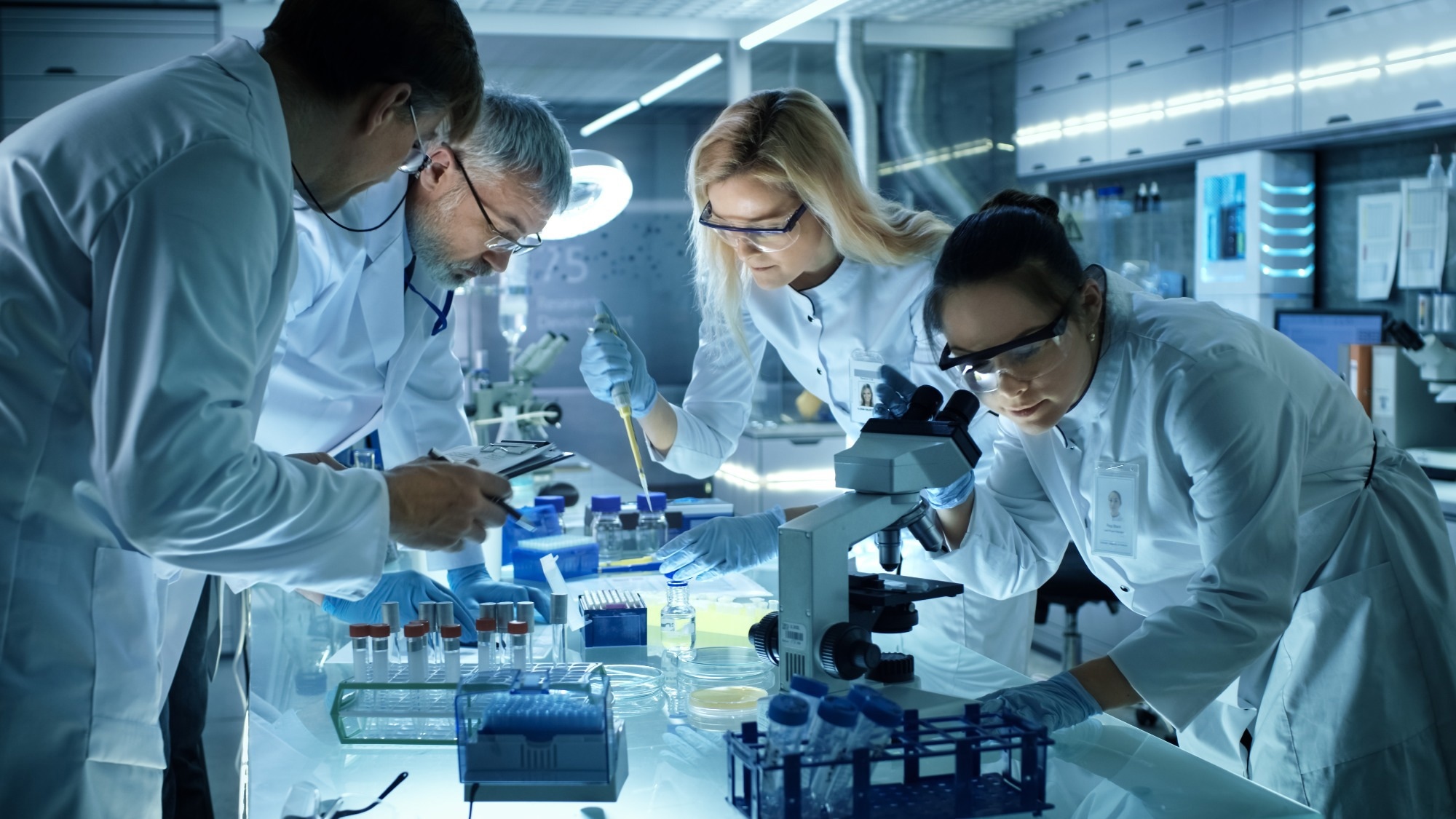Following ELRIGs Drug Discovery Conference, News Medical took part in an insightful discussion with Dr. Andrew Buchanan, a renowned figure in the realm of biopharmaceutical research. Dr. Buchanan's career spans 22 years, notably at Cambridge Antibody Technology, MedImmune, and AstraZeneca, where he has significantly contributed to the development of 18 antibody-based drugs, including three successful market products.
Today, Dr. Buchanan focuses on leveraging AI and machine learning for biologics and is at the forefront of tissue targeting technologies and scientific innovation in biologics. His election as a Fellow of the Royal Society of Chemistry in 2020 is a testament to his remarkable contributions, which include over 35 original manuscripts and patents.
In this interview, we'll delve into Dr. Buchanan's journey in the biopharmaceutical industry, his transition to AI/ML applications in biologics, and his vision for the future of drug development. Join us as we gain valuable insights from a leading expert in the field of biopharmaceutical research.
Can you provide us with an overview of your role at AstraZeneca and your journey in contributing to the development of antibody-based drugs?
Today, my role revolves around enabling the use of artificial intelligence and machine learning (AI/ML) in large molecule engineering, validating targeting technology across modalities, and driving biologics innovation through collaboration.
I started as a Research Scientist at Cambridge Antibody Technology (CaT) where I learned from colleagues the many scientific disciplines and leadership skills needed to develop antibody-based drugs. Working in collaborative teams at CaT, then MedImmune and AstraZeneca, I was fortunate to be offered increasing responsibilities and challenges.
This ultimately resulted in leading and mentoring teams into delivering 18 investigational new drugs, three of which are approved medicines, and many are currently progressing through the clinic.
 Image Credit: Krisana Antharith/Shutterstock.com
Image Credit: Krisana Antharith/Shutterstock.com
How does the incorporation of AI and machine learning influence the drug discovery process, and what potential impacts do these technologies hold for the future of pharmaceutical research?
AI/ML technologies are currently making a significant impact on the early drug discovery processes. In the first step of "choosing the right target," the incorporation of knowledge grafts and advanced analytics of deep 'omics data unlocks new insights and contributes to the development of appropriate wet-lab validation. This approach enhances target selection by leveraging vast amounts of data and identifying potential drug targets more efficiently. During the lead generation and optimization phases, AI image analysis plays a crucial role.
By providing fast and accurate analysis, it assists assay and pharmacology teams in making high-throughput and high-quality decisions on molecule triage and selection. This capability enables researchers to prioritize promising molecules for further development, saving time and resources. Furthermore, AI/ML tools are increasingly accurate in predicting the developability aspects of molecules.
This helps R&D colleagues select molecules with greater precision for progression to manufacturing science teams. As these technologies continue to advance, transitioning from classification to generative mode, they have the potential to assist teams in developing better, more effective, and cost-efficient treatments for patients.
Overall, the incorporation of AI/ML technologies in early drug discovery processes is revolutionizing the field, allowing for faster and more informed decision-making, and ultimately paving the way for the development of innovative and impactful treatments.
What inspired your transition into the realm of computational design and AI/ML within the biologics field, and how has this technology developed?
The potential applications of AI/ML in early drug discovery are vast. I entered the AI/ML space in 2016 focusing on applications related to large molecule design, from peptides to antibodies. To be honest, at first, I was skeptical. We started by identifying a few potential collaborators to evaluate the technology, build a strategy and early validation packages. At the beginning, progress moved slowly, but by working with brilliant peers, adopting a growth mindset, and learning as much as we could, we started to see success.
Some of this can be seen externally now in the peer reviewed literature from AstraZeneca PhD students, postdocs, and collaborators. The use of AI/ML in biologics science will continue to grow and become another tool in the toolbox for the successful bench scientist and project leader.
More specifically, could you share some examples of how computational design and AI/ML have accelerated the process of developing large molecule drugs in your experience?
Our goal as an industry is to get the right medicine to the right patient as quickly as possible. Working in the target selection to candidate drug preclinical space, the drive to get to First in Human studies results in a focus on accelerating timelines whilst also maintaining focus on quality.
From my perspective, AI/ML has great potential to enhance the quality of decision making within R&D. For example, the adoption of AI/ML tools by scientists will enable data democratization, better insight into specific scientific questions which will result in higher quality decisions being made throughout the project lifecycle.
Could you walk us through the importance of wet lab automation and data curation in the context of implementing machine learning in biologics research?
The end goal for all R&D lab work is to make successful candidate drugs that translate into medicines for patients. To enable that, machine readable and parsed data are becoming foundational for efficient day to day work, lab book writeups, decision making, and formal report writing.
To bring the potential of ML and related capabilities into biologics research, it is essential to have high quality data that approaches the standards of FAIR – findable, accessible, interoperable, and reusable. To exploit the power of AI, producing good data is essential, which is why it is necessary for researchers in industry and academia to continue the digital transformation of wet labs.
What key challenges or hurdles have you encountered while integrating computational and generative AI/ML applications into large molecule design, and how did you overcome them?
One of the key hurdles in building and validating this approach was cultural rather than technical. Bringing colleagues from disparate disciplines together - each with their own specialist language, overlapping terms and assumptions about data - meant that many things were initially lost in translation.
Spending time together to build trust, understanding, and insight into the key aspects of each other’s science was key and team members soon became comfortable in a new multilingual environment. Together, we built new inclusive and collaborative teams, demonstrating the value each member brought by understanding their views and expertise on each aspect of the strategy as it progressed.
 Image Credit: Gorodenkoff/Shutterstock.com
Image Credit: Gorodenkoff/Shutterstock.com
Can you highlight some of the notable achievements or breakthroughs in tissue-targeted therapy innovation that you and your team have been working on recently or will be working on in the future?
In targeted therapy, the drug is the ‘what’ and delivery is the ‘how’. The benefit of drug modalities, such as cell and gene therapy (CGT), with their associated DNA, RNA, chemistry, cell and particle technologies hold promise for transformative efficacy as medicines. At present, the limitation of this field is the delivery.
We are applying the decades of insights and learnings gathered from our Oncology teams at AstraZeneca about the use antibodies for targeted drug delivery to transform the delivery of CGT.
Being elected as a Fellow of the Royal Society of Chemistry in 2020 is a remarkable achievement. How has this recognition influenced your work and your perspective on the field of biologics?
As a biologist, being included in the chemical science community has been a privilege. One aspect of this is the potential to find experts and collaborators in fields of science different from the one where you’re an expert. Being able to frame questions and ask for help from other groups can bring a totally new perspective that drives innovation forward.
With over 35 original manuscripts and patents under your belt, what advice would you give to aspiring researchers and scientists looking to make significant contributions to the biologics field?
‘Crack on!’. It may sound flippant but what I mean is press ahead. To start with, it’s important to become an expert in your specialism and at the same time learn as much as you can from other experts. When you think you have a good idea, share it, discuss it with others, and then just give it a go.
Please don’t let aiming for perfection stop you. Sometimes the best results come from taking calculated and smart risks with the help and support of your team. True innovation rarely happens within your comfort zone, so don't be afraid step outside.
Where can readers find more information?
- Porebski BT, Balmforth M, Browne G, Riley A, Jamali K, Fürst M, Velic M, Buchanan A, Minter R, Vaughan T & Holliger P. Rapid discovery of high-affinity antibodies by deep screening. Nature Biomedical Engineering 2023 Oct 9. https://www.nature.com/articles/s41551-023-01093-3
- Paul D, Stern O, Vallis Y, Dhillon J, Buchanan A, McMahon H. Cell surface protein aggregation triggers endocytosis to maintain plasma membrane proteostasis. Nature Comms 2023 Feb 25. https://www.nature.com/articles/s41467-023-36496-y
- Schneider C, Buchanan A, Taddese B, Deane CM. DLAB-Deep learning methods for structure-based virtual screening of antibodies. Bioinformatics 2021 Sep 21;38(2):377-383. https://pubmed.ncbi.nlm.nih.gov/34546288/
- Krawczyk K, Buchanan A, Marcatili P. Data mining patented antibody sequences MAbs . 2021 Jan-Dec;13(1):1892366. https://pubmed.ncbi.nlm.nih.gov/33722161/
- Nimrod G, Fischman S, Austin M, Herman A, Keyes F, Leiderman O, Hargreaves D, Strajbl M, Breed J, Klompus S, Minton K, Spooner J, Buchanan A, Vaughan TJ, Ofran Y. Computational Design of Epitope-Specific Functional Antibodies. Cell Rep. 2018 Nov 20;25(8):2121-2131. https://pubmed.ncbi.nlm.nih.gov/30463010/
About Dr. Andrew Buchanan
 Andrew Buchanan is an experienced pre-clinical scientist, contributing to 18 antibody-based drugs entering first-time in human clinical studies of which to date three are marketed products. He is a versatile critical thinker with 22 years of experience (Cambridge Antibody Technology, MedImmune and AstraZeneca), and has led teams responsible for platform technologies and pipeline delivery to first in human studies. His current focus is on AI/ML for biologics, tissue targeting technologies and biologics relevant science innovation.
Andrew Buchanan is an experienced pre-clinical scientist, contributing to 18 antibody-based drugs entering first-time in human clinical studies of which to date three are marketed products. He is a versatile critical thinker with 22 years of experience (Cambridge Antibody Technology, MedImmune and AstraZeneca), and has led teams responsible for platform technologies and pipeline delivery to first in human studies. His current focus is on AI/ML for biologics, tissue targeting technologies and biologics relevant science innovation.
He was elected Fellow of the Royal Society of Chemistry in 2020 and, with colleagues, collaborators, postdocs, and PhD students, contributed to over 35 original manuscripts and patents. Career highlights so far have included being part of the teams that delivered IMFINZI®, PB2452 and time invested in mentoring peers.